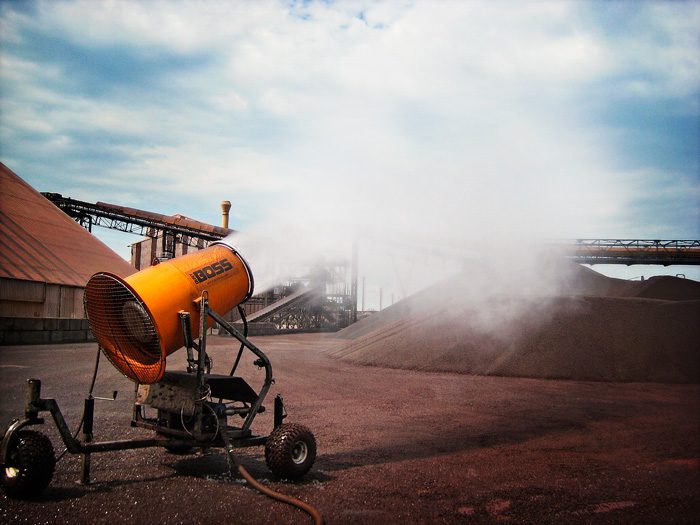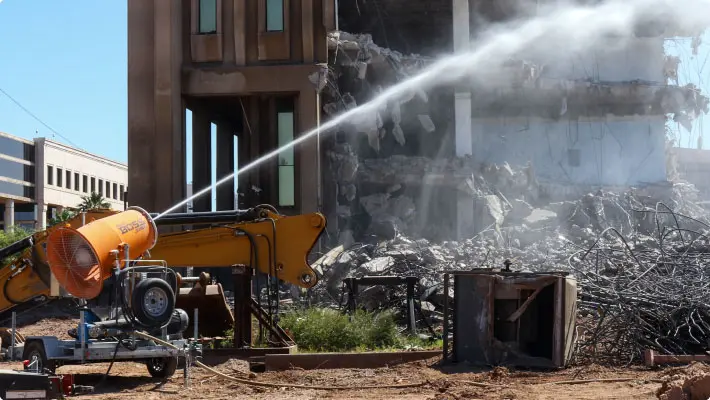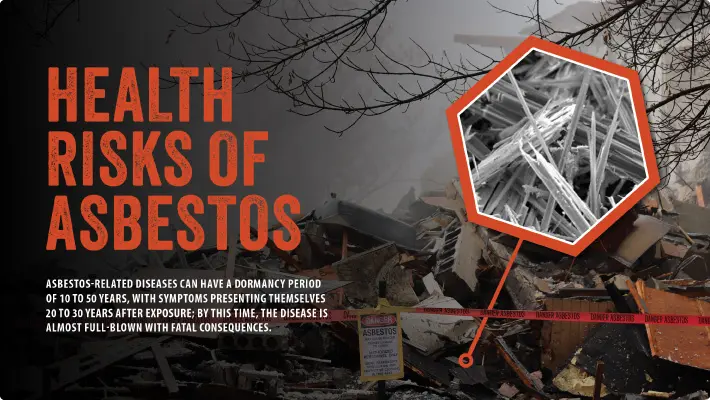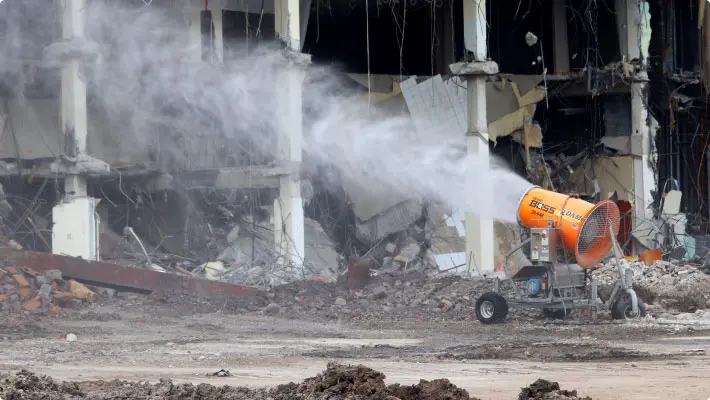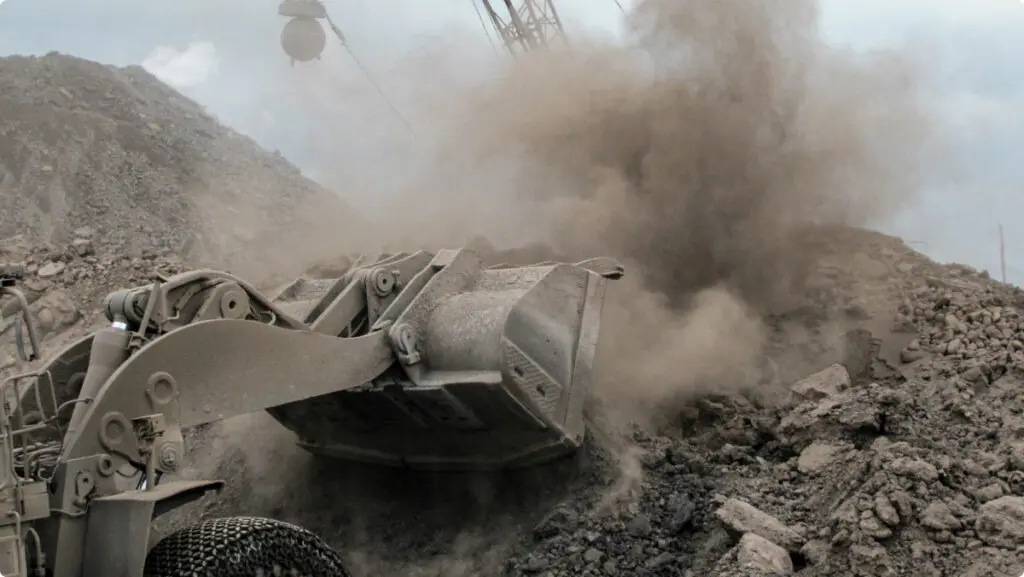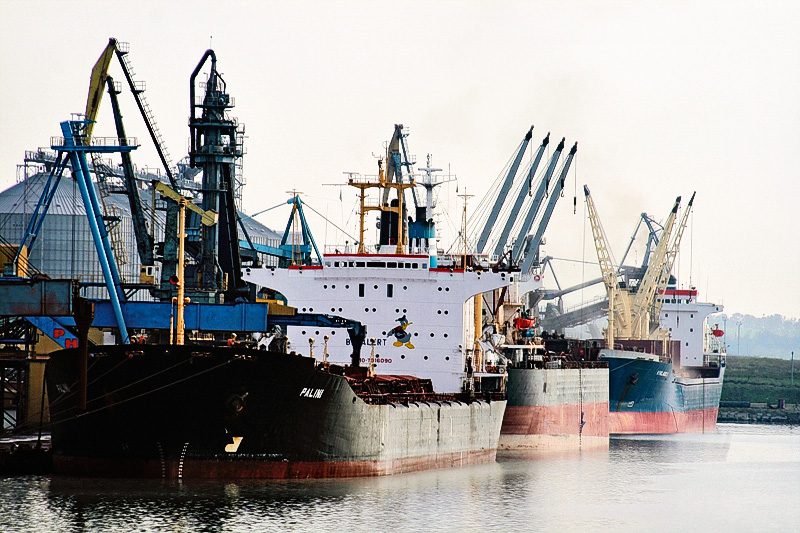
"We soon found that dust-related complaints had also dropped."
- Alexey Shlapakov
The key is a mobile dust suppression unit designed to produce massive numbers of tiny water droplets that are specifically sized to attract dust particles, then launch them with a powerful oscillating fan that can cover nearly half a football field with a dust-trapping mist.
Situated on the Black Sea at Adzhalik Bay, about 24 km south from the city of Odessa, TIS (TransInvestService Ltd.) specializes in transshipment of coal, grain, and fertilizers in bulk quantities.
With the opening of its new coal handling berth at the end of 2008 — and a terminal that has the estimated capacity to move 10 million metric tons per year — the facility greatly increased its already significant potential for dust.
“With the ability to handle such large quantities of dust-generating materials, we felt that some form of suppression had become a necessary element of port management,” said Alexey Shlapakov from TIS. “We have specialized equipment for many of our operations, and we started doing some research on the available dust control technologies. After comparing features and benefits, we specified a DustBoss model DB-60,” he said.
Dust management is becoming more critical all the time. What used to be considered an option a few years ago is now frequently a mandatory component of project planning. Tighter regulations and an overall enhanced environmental awareness are both contributing to that trend.
The port
"The air quality was noticeably improved, with a definite reduction in fine airborne particles."
- Alexey Shlapakov
The port has an average depth of about 14 meters and a quay wall that is more than 1,000 meters long. It features two ship loaders capable of handling 950 tons/hour and a portal crane with a lift capacity of 16 tons.
Situated on 500 hectares of land, the TIS facility has a loading capacity of up to 25,000 metric tons of coal per day, with warehouse storage for about 270,000 tons. It can also handle as much as 35,000 metric tons of grain per day, with warehouse storage for approximately 380,000 tons, and is equipped to load up to 25,000 metric tons of fertilizers per day, with warehouse space for about 270,000 tons. Company officials estimate that as many as 1,000 trucks can be loaded in a single day, or up to 250 railway cars.
With that kind of capacity, TIS needed a dust control solution to match. The DB-60 is built around a powerful 25 HP motor that generates 30,000 CFM, giving the unit a reach of 200 feet or more and allowing it to cover as much as 21,000 square feet of area.
It features 30 nozzles developed to atomize droplets to the optimum size for dust suppression — between 50 and 200 microns — and can be customized to suit specific particle sizes and operating conditions. The high-performance design includes an optional booster pump that delivers as much as 200 PSI of pressure from a 2" supply hose.
“We noticed the effects of the DB-60 right away,” Shlapakov said. “The air quality was noticeably improved, with a definite reduction in fine airborne particles. We soon found that dust-related complaints had also dropped. The unit has proven its value in service, under some very difficult conditions and has met all of our expectations.”
CUSTOMER
TransInvestService Ltd. (TIS)
LOCATION
Odessa Region, Ukraine
CHALLENGE
TIS recently opened a new terminal with an annual capacity to move 10 million tons of coal, grain, fertilizers, and other bulk materials through the country’s deepest port, situated on Adzhalik Bay. Company officials wanted to take additional measures to control dust migration and help prevent workplace hazards or nuisance dust.
SOLUTION
The powerful DustBoss DB-60 unit atomizes water droplets to the optimum size for particle capture, launching them 200 feet or more with a 25 HP fan that generates 30,000 CFM (nearly 850 cubic meters per minute). With its built-in oscillation, the DB-60 can effectively cover nearly half an acre (about .2 hectares) with a fine, dust-trapping mist.
RESULTS
TIS has significantly improved air quality and reduced dust-related complaints at the port, a busy marine facility where ocean-going vessels have 24/7 access to services. The firm reports that the DustBoss has proven its value under some very difficult conditions, and has met or exceeded expectations.
TIS is the Ukraine's largest private stevedoring company, located at the nation’s deepest freight harbor. Situated on Adzhalik Bay, which never freezes, even the largest ocean vessels have unrestricted access to services around the clock. The firm is equipped with grab loaders, 11 km of conveyors and other specialized equipment, earning it a reputation for rapid turnaround times.

"We soon found that dust-related complaints had also dropped."
- Alexey Shlapakov
The key is a mobile dust suppression unit designed to produce massive numbers of tiny water droplets that are specifically sized to attract dust particles, then launch them with a powerful oscillating fan that can cover nearly half a football field with a dust-trapping mist.
Situated on the Black Sea at Adzhalik Bay, about 24 km south from the city of Odessa, TIS (TransInvestService Ltd.) specializes in transshipment of coal, grain, and fertilizers in bulk quantities.
With the opening of its new coal handling berth at the end of 2008 — and a terminal that has the estimated capacity to move 10 million metric tons per year — the facility greatly increased its already significant potential for dust.
“With the ability to handle such large quantities of dust-generating materials, we felt that some form of suppression had become a necessary element of port management,” said Alexey Shlapakov from TIS. “We have specialized equipment for many of our operations, and we started doing some research on the available dust control technologies. After comparing features and benefits, we specified a DustBoss model DB-60,” he said.
Dust management is becoming more critical all the time. What used to be considered an option a few years ago is now frequently a mandatory component of project planning. Tighter regulations and an overall enhanced environmental awareness are both contributing to that trend.
The port
"The air quality was noticeably improved, with a definite reduction in fine airborne particles."
- Alexey Shlapakov
The port has an average depth of about 14 meters and a quay wall that is more than 1,000 meters long. It features two ship loaders capable of handling 950 tons/hour and a portal crane with a lift capacity of 16 tons.
Situated on 500 hectares of land, the TIS facility has a loading capacity of up to 25,000 metric tons of coal per day, with warehouse storage for about 270,000 tons. It can also handle as much as 35,000 metric tons of grain per day, with warehouse storage for approximately 380,000 tons, and is equipped to load up to 25,000 metric tons of fertilizers per day, with warehouse space for about 270,000 tons. Company officials estimate that as many as 1,000 trucks can be loaded in a single day, or up to 250 railway cars.
With that kind of capacity, TIS needed a dust control solution to match. The DB-60 is built around a powerful 25 HP motor that generates 30,000 CFM, giving the unit a reach of 200 feet or more and allowing it to cover as much as 21,000 square feet of area.
It features 30 nozzles developed to atomize droplets to the optimum size for dust suppression — between 50 and 200 microns — and can be customized to suit specific particle sizes and operating conditions. The high-performance design includes an optional booster pump that delivers as much as 200 PSI of pressure from a 2" supply hose.
“We noticed the effects of the DB-60 right away,” Shlapakov said. “The air quality was noticeably improved, with a definite reduction in fine airborne particles. We soon found that dust-related complaints had also dropped. The unit has proven its value in service, under some very difficult conditions and has met all of our expectations.”
Implement Dust Control at Your Jobsite!
Receive a FREE quote and talk to a dust control specialist today to stop fugitive dust!
Get A Quote
More on BossTek
Subscribe and Stay Up-to-Date!
Receive a monthly newsletter keeping you up-to-date on the latest in dust and odor control.
Subscribe
